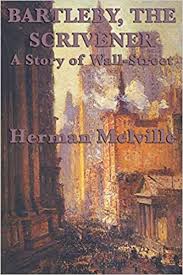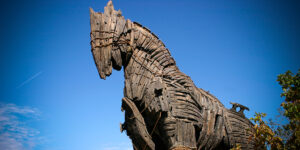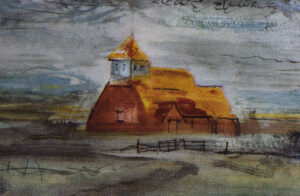There is a Bartleby cartouche in the latest issue of The Economist in which “loneliness” as one specific fallout from the COVID-19 pandemic is the central point.

The actual Bartleby is the hero, if that is the word, for the main character in a short story written by Herman Melville. Bartleby is a scrivener who, after a promising start in an office, ever after replies “I would prefer not to” when asked to perform a task. There thus is a progressive decline of this person who increasingly does nothing until ultimately, he dies of starvation.
In the midst of a pandemic, loneliness appears to be an appropriate topic, even though the current columnist concealed behind this non-de-plume is a journalist who has won awards for his ability to communicate, and who previously wrote the Buttonwood column in the same journal. Buttonwood was alleged to be the plane tree under which 24 gentlemen signed an agreement in 1792 which led to the establishment of the New York Stock Exchange. Hardly loneliness.
What the COVID-19 pandemic has shown is the way society in all its forms copes with solitude. Solitude is not loneliness. Yet loneliness is a by-product of solitude when it is enforced. Solitude is the monk in the cell where solitude is voluntary. Loneliness is the prisoner in solitary confinement where the outside world is through a grate high on the wall.
Solitude you can deal with on your own terms. Often, I used to go for walks alone because in solitude there is space. Night time was always a good time. I controlled those strolls in what I did; where I went; what I avoided.
Yet it is night time when loneliness is most prevalent. In daytime there are social and business contacts complemented by family; and for those without family then there were night time activities – bars, theatre, nightclubs, gambling. At least before the pandemic. Lockdowns and curfew changed that with the advance of the Virus and enforced self-isolation has aggravated the sense of loneliness. After all, being alone and sober and awake at three am – the witching hour – is a complete test of loneliness.
I have written before of the image of the politician, the man and less commonly the woman, alone in the staged photograph. This image is interpreted as a sign of strength, until you realise that behind that camera lens is a mob, ready to engulf “the person alone” who is paradoxically the centre of attention, even when the photographic image would ask you to believe otherwise.
Now that I spend many hours in “retirement”, is it solitude or loneliness when the phones have stopped ringing and there are days when nobody calls? It must be difficult when you go into a gated community for the aged where you have no companions, except the fell sergeant. Increasingly your friends and acquaintances have gone with him – and thus it’s a lonely crowd.
But real loneliness is when your partner walks out on you, becomes demented or dies. Loneliness thus is when you have no control, when you realise power has been taken from you, a situation which leads you to the conclusion that life eventually will become intolerable. Pandemic or not, there is an inevitability with age that once lost, societal relevance is never regained without help.
In a pandemic, there need to be ways in which loneliness can be ameliorated. The Bartleby column provides some limp commentary. Technology does provide some relief, but there is always going to be an artificiality whenever any of one’s senses is blocked, as they are by technology. You can see and hear using texting, zooming, phoning or whatever. But you have no sense of the proprioceptive influence of the whole person with whom you are interreacting remotely. So, when the technology is switched off, then you are alone. Normally proprioception is considered an introspective sense, like one navigating a dark room, and knowing that it is your head which bumps the ceiling not your foot.
But what I call proprioceptive influence is how you react when you meet anybody. You immediately sense the space that person inhabits and how it is affecting you. Crucially this interaction depends on face to-face contact. Zoom can cut that sense right out. You also enter into that artificial world of constant texting to convince yourself you are not alone, until no-one responds.
In doing so ever more frantically, loneliness is enhanced. The external proprioceptive influences are lost. Once the stimulus of this external proprioception is lost, then one is at first lonely and then like Bartleby – some may say profoundly depressed until death relieves the pain of loneliness.
Brisbane West – A Quirk of Nature
Below is part of an email I wrote to a friend on January 25. Having been there on a number of occasions, I canvassed the use of Toowoomba (Wellcamp) as a site for quarantine.
The Wellcamp airport facility at Toowoomba is impressive. The Brisbane Lord Mayor Quirk lived up to his surname when he objected to it being called Brisbane West. Don’t know why?

A quarantine facility here is very feasible, constructed at this airport which is surrounded by plenty of broad acres; the transfer time from the spacious terminal to the potential facility is negligible. It was ludicrous to hear one of those cossetted commentors on the ABC this week saying that the dangers of being cloistered in cars with others for hours, travelling to hypothetical remote facilities beyond some black stump or two. She must have been watching too much of “Back Roads”.
The Wagner brothers, who built the Wellcamp airport without subsidy, represent the very best – honest and tough, as Alan Jones found out. It is a pity that when the Prime Minister went to Queensland recently, it seemed mostly to go to Katter’s demesne. I hope Morrison understands that politics in Queensland is dynastic. The Premier herself is a prime example. In Kennedy, Robbie Katter is next in line, outwardly different from his father but still just as canny. John McVeigh recently stepped down as the local member for Groom, a seat his father Tom held until 1988. Pity the Prime Minister did not take in Toowoomba during that last trip. As I wrote:
To me the fact that our health system is operating well, where there is no need for vaccines, must be beneficial to the business community. Everybody wants the magic bullet, but it does not exist, except in very rare circumstances and then admittedly it changes society – take antibiotics for instance. But on the other hand, we are far from conquering cancer, but that has been factored into our daily life, and you would know as an economist. We have cancer centres, and there is thus some degree of certainty, which is bolstered by such measures as “five year survival rates”. I would not put a lot of faith in the vaccines until I know whether they work or not. Yes, they say governments have thrown a lot of money at it, but that does not necessarily provide a solution to a virus which can rapidly mutate.
Do what we are doing? Keep it out of the country is the first response. If the vaccine works, good. But like the ill-fated App which was supposed to locate the infected, don’t bet your house on its efficacy.
Sorry about the cruises and the overseas trips. I remember my father went back to England in 1919 and then apart from the War did not go overseas until 1953. My mother never did. I do not know what your father and mother’s experience was. The world did not come to an end, but as I remember it, travelling was expensive, especially by plane – and perilous. When I first went overseas in 1956, I had smallpox, typhoid (which gave you a painful arm and was not very effective) and cholera vaccinations. I think it was the year we all had our Sabin. Apart from that we had triple antigen as children. Therefore, we will have to adapt to a fortress nation, just as we did between 1939-45.
Business will adapt, as I said above, to there being no magic bullet. There are always going to be smarties on the stock market, but presumably with ongoing exchanges as you and I are having, information (in the health sector) becomes less asymmetric because of such exchanges.
What Australia needs are dedicated quarantine facilities in just the same way as we have emergency services. I advocated for them in an August Blogs (No76 & 78). We have ambulance services although less than 10 per cent of their time is spent on emergency work. But we need them standing by. Thus, there will be a great deal of downtime, but at least quarantine facilities will be dedicated, and not be non-purpose-built hotels. In the short term, because government is not faced with capital costs, they will continue to use hotels, but the Queenslanders have the solution borrowed from the NT – disused mining camps kept in good nick. If Victoria had these, it would not be going through the trauma of the tennis “bratology”.
The next argument used will be that no health professionals will want to go to them. I battled this furphy for 10 years setting up the rural clinical schools, and they have been hugely successful. Students now want to go. Therefore, following the success of clinical schools, put incentives like specialist research facilities alongside the quarantine facilities, even drug manufacturing facilities. Rural Australia has plenty of space.
Take the concept of Toowoomba being one such area. Ever been to the Wagner privately built airport? It can take the biggest air freighters, because the idea was to export beef and other livestock from there without needing to go to the coast. International planes could easily be diverted there. Exmouth is another where, when they left, the Yanks left fully operational hospital facilities. God knows whether they have been maintained.
From the outset of the pandemic, I have always advocated permanent dedicated quarantine facilities and if this had been the original intention Australia would have been spared all the problems that inappropriate hotel quarantine has caused. The Wagners of Toowoomba have now proposed they build a large quarantine facility adjacent to the Toowoomba airport, with accommodation and facilities for staff and testing. International flights can land there and quarantining passengers would be in the facility within minutes.
While there is a reluctance to admit the original hotel quarantine had more to do with the economics of the hotel industry, hotels have been adapted, at a cost, to having a quarantine role. Having said that, I have never seen a unit cost of an average hotel stay compared with that of the Howard Springs facility, which seemed perfectly adequate for the first tranche of evacuees from Wuhan.
When I raised this idea at the time with a former Departmental head, he said that the cost of building from scratch would be daunting. However, as I replied, they would provide more protection than of couple of unusable submarines which may never be constructed, at the cost of how many millions, or billions?
And from The Boston Globe at the weekend…
The 66 per cent global effectiveness rate for the one-shot vaccine fell significantly short of the performances of the two-shot vaccines from Pfizer-BioNTech and Moderna that the FDA cleared for emergency use in December. Those vaccines prevented more than 90 percent of coronavirus cases in large trials, a remarkable showing considering that they were the first to successfully use new synthetic messenger RNA technology.
Dr. Dan Barouch, who runs the Center for Virology and Vaccine Research at Beth Israel, which developed different technology for the (Johnson & Johnson) vaccine, said the pandemic has evolved, with the emergence of more resistant variants, in particular a worrisome South African strain that was detected in the United States for the first time last week.
Several vaccine experts agreed and highlighted a particularly encouraging finding in Johnson & Johnson’s announcement last week: The one-shot vaccine was highly protective against the worst cases of COVID-19. Worldwide, the shot prevented 85 percent of severe cases, and none of the vaccinated people needed hospitalization or died from COVID-19.
Dr Fauci acknowledged last week that public health officials will likely face a “messaging challenge” to persuade people to take a vaccine that prevented 66 percent of symptomatic cases compared with roughly 95 percent.
But, he said, “If you can prevent severe disease in a high percentage of individuals [as the Johnson & Johnson vaccine did], that will alleviate so much of the stress and human suffering and death.”
He and other officials also said the Pfizer and Moderna vaccines would likely get lower efficacy results now, given the emergence of the South African strain, which appears to be more resistant to immunization.
The FDA said last summer that a vaccine that was safe and at least 50 percent effective would likely be cleared for use. The annual flu vaccine is typically 40 to 60 percent effective at preventing influenza cases, according to the Center for Disease Control and Prevention.(CDC)
The Johnson & Johnson coronavirus vaccine relies on a design that Barouch pioneered nearly 20 years ago for two experimental vaccines that have shown promise against HIV and Zika, and a third vaccine that won approval from the European Union in July to prevent Ebola.

It uses a harmless and relatively rare cold virus, adenovirus serotype 26 ― or Ad26 ― as a Trojan horse to deliver part of the distinctive spike protein on the coronavirus surface into cells to trigger an immune response without making people sick.
Despite its lower performance in preventing all COVID-19 cases, the Johnson & Johnson vaccine has major advantages over its Pfizer-BioNTech and Moderna rivals. By requiring only one shot, it would simplify and speed the vaccine campaign. In addition, it is stable at refrigerated temperatures, unlike the other vaccines, which must be frozen at ultracold temperatures when shipped and stored before use.
The FDA cleared the Pfizer-BioNTech vaccine on Dec. 11 and the Moderna vaccine a week later. But their rollout has been frustratingly slow and cumbersome, and public health officials want more vaccines from other drug makers to bolster the supply. As of Thursday, the government has distributed more than 57.4 million vaccine doses, and 27.9 million people have had one or more shots, according to the CDC.
Dr Eric Rubin, (the editor -in-chief New England Journal of Medicine and member of the FDA advisory panel), said Thursday that “it’s been frustrating how long it’s taken to roll out vaccines, but if everything were perfect and we had a perfect distribution system, we’d run out of vaccines really fast. We just don’t have enough supply.”
Therefore, vaccination in America has been beset by a number of problems with open criticism by the experts, especially given how slow and complicated the rollout has been, if the above quote gives a reliable picture.

One benchmark which politicians will always grasp when justifying their decisions is the places where the rate of vaccination has worked well. Israel seems to be the shining example.
Three million one hundred thousand Israelis have been vaccinated and 1.8 million have had their second dose. It is rumoured that Israel paid Pfizer far more than other countries to receive preference; hence there have not been any questions raised over the supply line integrity. Israel is a wealthy country, well able to afford paying a premium. Israel is also the 150th largest country in the world, and that makes lines of supply relatively short; and given that Israel seems to be on permanent war-alert, then it is reasonable to believe the bulk of the population are more disciplined and compliant without coercion.
Israel has the luxury of having apparently solved the supply chain problem and systematically collected data which have shown (in peer reviewed journals) that the vaccination is 50 per cent effective 13 to 24 days after vaccination. Nobody under 16 is being vaccinated; nor any of those who have been certified as being infected before vaccines became available. 7,000 cases had thus been previously recorded with 10 per cent having had “moderate to critical illness”. There were 307 deaths. To put all of this into perspective, Israel has a population of just over 9 million.
After vaccination in the vulnerable over 60 age group, only 531 of almost 750,000 have developed symptoms of the virus, with 38 requiring hospitalisation; there were three deaths. Not a bad interim outcome, but it is early days and there is evidence of spaces in knowledge still to be filled. The obvious question is how generalisable is the Israel experience? What gives some comfort is that the Israelis seem to have an excellent data collection.
The Churches of Romney Marsh
I have stayed on Romney Marsh and have watched the eastern sky darken across the dyked flats to Dymchurch and the Channel towards the French coast as the sun set at my back and have noticed the strange unity of sea, sky and earth that grows unnoticed at this time and place – Paul Nash 1940
John Piper knew the artist who penned the above quote well. He himself was a very prolific English artist, and besides his artwork he was known for his stained glass. Much of his work can be found in churches across England. My starkest memory of his work is the red centrepiece in tapestry daubed with Christian symbolism and surrounded with panels of purple, green and blue which shines in all its vibrant entropy out of the gloom of the sanctuary in Chichester Cathedral. Funny word “stark” to describe a brilliant multi-coloured woven cloth; but there you are. It absolutely complements the severity of its environs.

I first read the name John Piper some years ago on a King Penguin “Romney Marsh”. Even before I had laid eyes on the book, the name “Romney Marsh” conjured up a sense of mystery because it always looked so desolate. Normally to offset the bleakness, the photographs were always dotted with sturdy, white faced Romney sheep with their cream fleece.
Romney Marsh as described by Piper in words and in his sketches of the villages but particularly the churches, encouraged us to visit there. This happened to be on a characteristically windy and grey day. In the distance on the Dungeness headland are the twin grey blocks of the nuclear power stations, which were working when we there, but have since been shut down for safety reasons – temporarily until the engineers get things right. Stretching away from these blocks was this severe wasteland, and one might have expected the spectre of T.S Eliot tripping through the low undergrowth and holly bushes.
The nuclear power station was not there when John Piper prepared his book. However, there were watercolours of the circular black and white painted brick lighthouse and the keeper’s house. This was replaced in 1961 by a far higher concrete structure, so as not to be obscured by the nuclear power station. This latter one is floodlit so the birds can avoid it but the two lighthouses (one now a tourist attraction from which to see the land and sea) exist side by side, testimony to the advances in “lamp” technology over the centuries since the first was constructed.
When we there we avoided the villages (Romney was one of the Cinque Ports of which our beloved homegrown Knight of the Thistle was Warden, sandwiched as he was between Churchill and the Queen Mother). We concentrated on the churches, many of which were isolated and only accessible if we walked across the squelching terrain. For although the Marsh has long since been drained, lying as it does between shingle shores, there are still marshy reedy areas.
As is said, from most areas of the Marsh, a belfry, tower or steeple are visible, so ubiquitous are these churches. Most of the Marsh population in the eighteenth century was engaged in smuggling wool and Fuller’s earth (a form of clay used in cleaning and purifying) to France; and brandy, silk and lace from France. The churches became useful storage facilities, even extending to the use of empty stone lidded coffins. The churches were therefore a crucial link in the black economy of the time.

Our visit was a far more pedestrian in more ways than one. We chose to visit the churches where, in his book, Piper had inserted coloured plates: St Thomas of Canterbury – Fairfield, St George – Ivy Church, St Clement – Old Romney and St Mary – East Guildford. We visited some others as time permitted.
There are 27 in all, one meriting a one-line description, “fragment of a ruin, near a farm”, and others not much more. Some of the churches exhibit Norman influence and can be traced back to the fourteenth century. Many have been modified and in some cases such as St Thomas squatting as it does in the middle of a field have been restored. Otherwise, the seven-word description above indicates in this comprehensive list there are still ruined remnant churches.
Wandering around Romney Marsh is just one example of being alone in history, as it can be found in the churches. In this case, we were very lucky to have this bonus, John Piper’s comprehensive and illustrated guide.
Mouse Whisper
And now again for something completely different: what a revelation to watch a film, The Man Who Knew Infinity, about the life of the Indian mathematical genius, Srinivasa Ramanujan. His mentor at Cambridge was G.H. Hardy who, with his colleague J.E. Littlewood, were already mathematical luminaries at Cambridge when Ramanujan came there just before World War 1. The fact that these men went by initials rather than names indicated the stitched-up era in which these academics lived.
The last scene in this brilliant film shows the two men, Hardy and Littlewood – Ramanujan having just died in India of TB at the age of 32 – seeing a taxi labelled 1729 and saying, we must take that one.
This taxi number, as my master found out, was a bit of a complex mathematical licence.
In fact, the actual truth was that Hardy had once taken a cab to visit Ramanujan. When he got there, he told Ramanujan that the cab’s number, 1729, was “rather a dull one”. Ramanujan said, “No, it is a very interesting number. It is the smallest number expressible as a sum of two cubes in two different ways. That is, 1729 = 1^3 + 12^3 = 9^3 + 10^3.” This number is now called the Hardy-Ramanujan number, and the smallest numbers that can be expressed as the sum of two cubes in n different ways have been dubbed taxicab numbers.
I now know what the last scene in the film is about; well, sort of. Need to consult that mathematical doyen of the murine world, Bertie Rustle.

